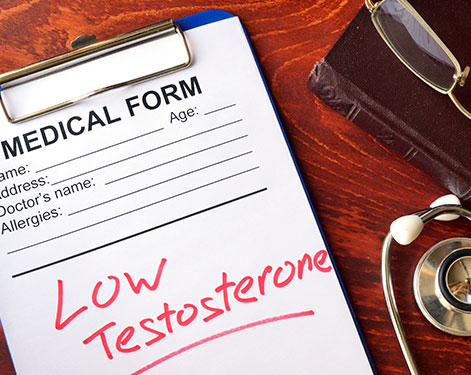Get Started
Complete the short form belowto Contact a Nexel Medical physician

Low testosterone can have negative health impacts for men as well as women.
Testosterone is an androgen or male hormone. It is, in fact, the most important male hormone. However, women’s bodies make and need testosterone too. Testicles primarily make testosterone in men. Women’s ovaries also make testosterone, though in much smaller amounts.
Low testosterone, a condition also known as hypogonadism, is when your body is not making enough testosterone. This is also known as having a testosterone deficiency. There can be several causes for testosterone deficiency.
Any disease or condition that impacts your body’s ability to produce testosterone can lead to low testosterone. However, the most common reason for low testosterone – particularly in men and women between the ages of 40 and 65 – is the natural decline in testosterone that occurs as we age. Doctors refer to this as “age-related testosterone deficiency.”
The only way to treat low testosterone is with testosterone replacement therapy. Low testosterone treatment may also include lifestyle counseling. You may be asked to change your diet and other habits to help maintain your results of testosterone replacement.
There are many life-changing benefits of testosterone therapy for men and women with low testosterone. The benefits of low testosterone treatments include:
Low than normal testosterone levels can cause significant quality of life issues for men. Testosterone is the most important male hormone. It affects everything in men, from sperm production to libido. Male fetuses begin to produce testosterone in the womb, and testosterone levels increase throughout early life.
In men, they rise dramatically during puberty, peak during the late teen years, and then level off in the 20s. After age 35 or so, a man’s testosterone levels start to regularly decrease every year.
Throughout a man’s life, his testosterone levels impact:
Low testosterone in men can and does negatively impact all of the above.
While testosterone is a vital male hormone, women need and produce testosterone as well. A woman’s body makes only a fraction – about 1/10th to 1/20th — of the amount of testosterone that men do. However, it still plays an essential role for females. In women, testosterone plays an important role in:
Just as in men, women lose testosterone as they age. In fact, recent studies have shown that it is the loss of testosterone, and not estrogen, that accounts for most of the debilitating symptoms, such as hot flashes and night sweats, that we usually associate with menopause.
Your testosterone levels decline as you age because it is natural for them to do so. Men, in particular, need high levels of testosterone as they grow from boys into men. Testosterone is largely responsible for the maturation of the sex organs and the secondary sexual characteristics we associate with “maleness” – facial hair, deeper voice, larger muscles, etc.
Testosterone levels continue to be high through puberty and adolescence as a young man achieves full stature, peaking at about the age of 20. After the age of 30, a man’s testosterone levels naturally decline on average, about 1% to 2% per year.
The amount of testosterone your body makes varies as you age, in both men and women.
Testosterone levels are measured in nanograms per deciliter (ng/dl). Normal testosterone level varies by age and sex. The following charts indicate the normal testosterone levels for men and women at different stages of life.
Infants and children
| Age | Male (in ng/dl) | Female (in ng/dl) |
| 0 to 5 months | 75-400 | 20-80 |
| 6 months to 9 years | Less than 7-20 | Less than 7-20 |
| 10 to 11 years | Less than 7-130 | Less than 7-44 |
Adolescents
| Age | Male (in ng/dl) | Female (in ng/dl) |
| 12 to 13 years | Less than 7-800 | Less than 7-75 |
| 14 years | Less than 7-1,200 | Less than 7-75 |
| 15 to 16 years | 100-1,200 | Less than 7-75 |
Adults
| Age | Male (in ng/dl) | Female (in ng/dl) |
| 17 to 18 years | 300-1,200 | 20-75 |
| 19 years and older | 240-950 | 8-60 |
There are many signs and symptoms of testosterone deficiency.
Many of the signs and symptoms of testosterone deficiency overlap between men and women. However, there are some symptoms of testosterone deficiency that are only experienced by women, and some that are only felt by men.
Generally, testosterone deficiency impacts three major areas of your life: your physical wellbeing, your emotional wellbeing, and your mental acuity. Broadly, the signs and symptoms of testosterone deficiency are a decreased sex drive, fatigue, weight gain, loss of muscle and bone mass, and changes in mood.
Some of the most common signs and symptoms of testosterone deficiency and why they occur include:
Testosterone is a precursor to the release of nitric oxide during sexual arousal, which starts several reactions that result in an erection.
Men and women experience hair loss as they age. Often this is the result of age-related testosterone decline.
Testosterone helps to produce bone tissue and maintain bone mass and density.
Patients with low testosterone report difficulties in falling asleep or staying asleep. This could be because low T can lead to obesity, which can lead to sleep apnea.
Both men and women with testosterone deficiency experience a decrease in sex drive.
Testosterone plays a role in the development of muscle mass. Testosterone deficiency often results in significant loss of muscle mass.
We used to think that loss of estrogen was responsible for the hot flashes and night sweats experienced by menopausal women. We now know that hot flashes, and many of the debilitating symptoms of menopause, are more likely caused by testosterone deficiency in women.
Some of the other common symptoms of testosterone deficiency include:
Some of the less common signs and symptoms of testosterone deficiency in men and women include:
Several factors can contribute to testosterone deficiency. Not getting enough exercise, doing the wrong kinds of exercise, a poor diet, metabolic conditions such as diabetes can all lead to low testosterone. However, the most likely cause of testosterone deficiency is the normal drop in testosterone levels that occur as you age.
By the time you are 40, your testosterone levels decline at a rate of about 1-2% per year. This can lead to the signs and symptoms of testosterone deficiency.
Testosterone is only legally available with a doctor’s prescription. Before you can be prescribed any kind of testosterone replacement therapy, you must be diagnosed with low testosterone. A blood test will provide your healthcare provider with the most accurate picture of your testosterone levels.
There is no special preparation needed for the test doctors use to see if you qualify for a testosterone prescription. Over 95% of the testosterone that circulates in your blood does so as bound testosterone, so-called because it is bound or tied to other things in your blood, like certain protein molecules.
A much smaller amount exists as free testosterone. However, both are what we call “bioavailable” and can interact with target tissues and stimulate testosterone-reliant processes. A typical testosterone blood test will look for both or the total volume of testosterone in the blood.
If you have been diagnosed with low testosterone, the only medical treatment is a prescription for testosterone replacement therapy.
Regardless of how many of the signs and symptoms of low testosterone you are exhibiting, testosterone deficiencies in men and women are treated the same way – with testosterone replacement therapy.
Testosterone therapy is only available with a doctor’s prescription. Your doctor will prescribe testosterone replacement after your testosterone levels have been tested. If your levels are low enough to be diagnosed with a testosterone deficiency, you will be prescribed testosterone replacement therapy.
As the name implies, testosterone replacement therapy can give you back what time and nature take away. Testosterone replacement therapy is usually prescribed as a course of daily injections, usually for six months initially.
Testosterone replacement is the safest and most effective way to treat the symptoms of low testosterone. You will not see overnight results from your testosterone therapy. Your prescription for testosterone therapy will be designed for your body to react to the increases in testosterone slowly over time. The life-changing benefits of testosterone replacement for patients with low testosterone will impact four major areas of your life:
Your results of testosterone therapy will benefit you in each of these areas of life. The many benefits of testosterone replacement for treating low testosterone include:
There are several forms of testosterone medication. Low testosterone medications can be prescribed as topical gels and creams, subdermal pellets, skin patches, or testosterone injections. Our doctors have found testosterone injections to be the safest and most effective type of low testosterone treatment.
Testosterone injections are prescribed as different “esters.” Esterification is a chemical process that makes testosterone more soluble and therefore injectable. Each “ester” is simply a different chemical form of testosterone.
The most commonly prescribe esters of testosterone are testosterone enanthate, testosterone cypionate, or testosterone propionate. The three types of testosterone injections differ in how long they last and how quickly they act.
Testosterone Enanthate – Testosterone enanthate tends to stay in the blood for about four to five days. Testosterone Enanthate is given as an intramuscular injection, usually every five to seven days.
Testosterone Cypionate – Testosterone cypionate is considered to be a “longer-acting” testosterone than enanthate. It tends to take seven to eight days to be fully metabolized. Cypionate is often begun with a starting dose similar to enanthate, but since it lasts longer, it is only administered every seven days.
Testosterone Propionate – Of the three types, testosterone propionate is considered to be the “fastest acting.” Testosterone propionate has been known to peak in the blood within hours of being injected. It can be metabolized in as little as three days. Testosterone propionate injections should be administered every two to three days.
Of the three types of testosterone discussed on this page, testosterone cypionate is the most commonly prescribed. The most popular brand of testosterone cypionate is Depo-Testosterone. It is more commonly known as “Depo.” Depo was the first testosterone injectable approved by the FDA. It has been produced by Pharmacia and Upjohn since 1979.
All three of the types or esters of testosterone discussed on these pages generally have the same long-term benefits. The real difference lies in that some are “fast-acting” while others are “long-lasting.” Of the three types, testosterone propionate is considered to be the fastest-acting, while cypionate is the longest lasting.
Now that you know a lot more about low testosterone, why not take a minute to contact us and learn more about how testosterone replacement therapy can improve your quality of life.
Complete The Short Form Below To Contact a Nexel Medical Physician
